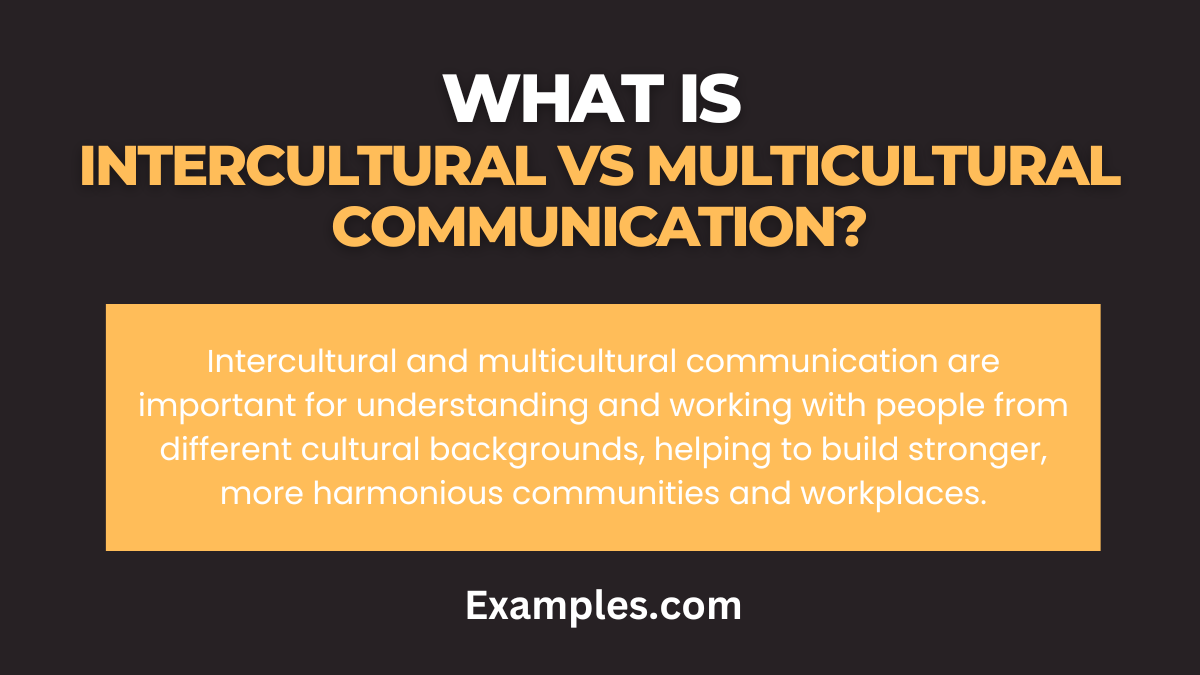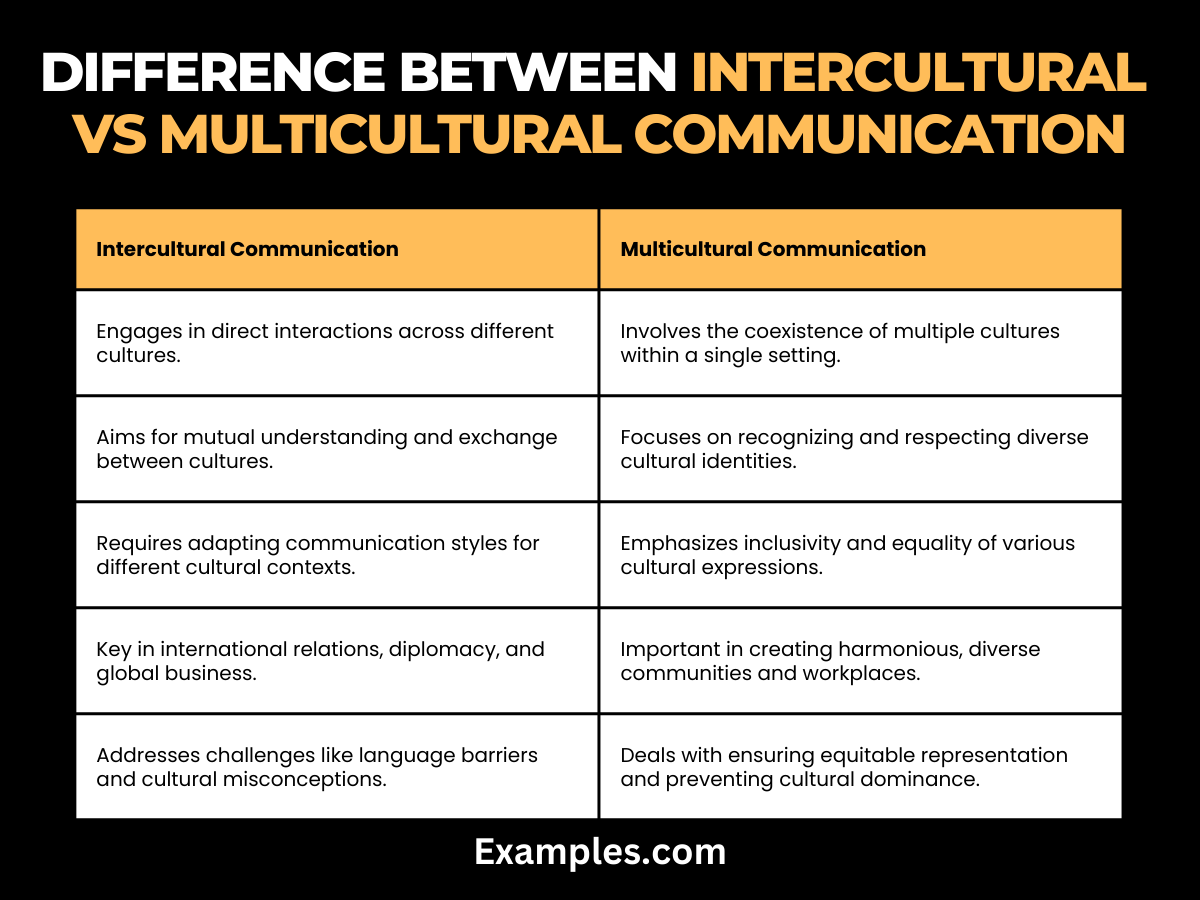Intercultural vs Multicultural Communication
Dive into the dynamic realms of Intercultural and Multicultural Communication with this insightful guide. Understand the subtle yet significant differences between these two types of interactions that are pivotal in our globally connected world. Featuring enriching Intercultural Communication Examples, this guide explores the nuances, strategies, and practical applications of both communication forms. Ideal for professionals, educators, and students, it offers valuable insights into effectively navigating and fostering understanding in diverse cultural landscapes.
What is Intercultural vs Multicultural Communication?

Intercultural Communication refers to the interaction between individuals from different cultural backgrounds. It focuses on how people from diverse cultures communicate with each other, often requiring the understanding and adaptation to different cultural norms, values, and communication styles. Intercultural communication is key in scenarios like international business, diplomacy, or when people from different countries collaborate. It’s about bridging cultural gaps to ensure effective and respectful exchange of ideas.
Multicultural Communication is about the coexistence and interaction of multiple cultures within a particular community or organization. It emphasizes the importance of acknowledging, respecting, and valuing diverse cultural perspectives and practices in a shared space. Multicultural communication is essential in diverse societies, educational settings, or workplaces, where inclusivity and cultural representation are prioritized. It’s not just about communication between cultures but also about creating an environment where all cultural identities are equally recognized and valued.
Difference Between Intercultural and Multicultural Communication
In the realm of Intercultural Communication, distinguishing between intercultural and multicultural communication is key for understanding their roles in managing cultural dynamics. The following table provides an in-depth comparison of these two forms of communication:

| Intercultural Communication | Multicultural Communication |
|---|---|
| Involves direct interaction between individuals from different cultural backgrounds. | Encapsulates the coexistence of multiple cultures within a particular community or organization. |
| Aimed at fostering understanding, negotiation, and collaboration across cultures. | Focuses on acknowledging, celebrating, and respecting a variety of cultural identities. |
| Requires active engagement in cross-cultural dialogues and exchanges. | Emphasizes an environment where diverse cultural practices are observed and respected. |
| Often demands adaptability and flexibility in communication to understand cultural nuances. | Involves creating inclusive spaces that recognize and value cultural diversity. |
| Engages in problem-solving and conflict resolution across cultural boundaries. | Promotes policies and practices that ensure equal representation of different cultures. |
| Essential in situations like international diplomacy, global business, and multicultural teams. | Vital in socially diverse settings like multicultural cities, educational institutions, and global organizations. |
| Challenges include navigating cultural misunderstandings and stereotypes. | Challenges involve preventing cultural dominance and ensuring fairness in cultural representation. |
| Develops intercultural competencies, such as empathy and cultural sensitivity. | Involves understanding and implementing principles of cultural equity and inclusion. |
| Examples include international collaborations, expatriate assignments, and global leadership roles. | Examples include multicultural education programs, diverse community projects, and inclusive corporate policies. |
| Plays a crucial role in enhancing global communication and international relations. | Important for creating harmonious, culturally diverse societies and workplaces. |
| Involves learning and respecting foreign languages and customs. | Encourages the celebration of cultural events from various cultures within a community. |
| Seeks to reduce cultural barriers and promote global understanding. | Aims to build a society where cultural differences are not just tolerated but valued. |
10 Examples of Intercultural Communication
In today’s globalized world, intercultural communication plays a vital role in fostering understanding and cooperation among people from diverse cultural backgrounds. Here are ten distinct examples of intercultural communication:
- Business Negotiations: When negotiating with international partners, understanding their cultural values and communication styles is essential for a successful outcome. For example, in some cultures, building a personal relationship before discussing business is customary.
- Cross-Cultural Training: Organizations provide employees with training to navigate cultural differences effectively. This includes understanding gestures, taboos, and etiquette in various cultures.
- International Diplomacy: Diplomats engage in intercultural communication to build relations between countries. Cultural sensitivity can prevent misunderstandings that may lead to conflicts.
- Language Exchange: People from different language backgrounds often engage in language exchange programs, allowing them to learn about each other’s cultures while improving language skills.
- Cultural Festivals: Participating in or attending cultural festivals is a way to experience and appreciate different cultures’ traditions, music, dance, and cuisine.
- Multinational Team Collaboration: In multinational companies, teams may consist of members from various countries. Effective intercultural communication is vital for teamwork and project success.
- Tourism and Hospitality: Professionals in the tourism industry must adapt their communication to cater to tourists from different cultural backgrounds, ensuring a positive experience.
- International Education: Students from around the world study abroad, requiring educators to adapt their teaching styles and communication to accommodate diverse learners.
- Cultural Exchange Programs: These programs allow students, professionals, and individuals to immerse themselves in another culture, learning firsthand about its customs, values, and communication norms.
- Media and Entertainment: Movies, television, and literature often portray characters and stories from different cultures, promoting intercultural understanding and awareness.
10 Examples of Multicultural Communication
Multicultural communication occurs within diverse communities, emphasizing interaction among individuals from various cultural backgrounds. Here are ten examples highlighting the significance of multicultural communication:
- Workplace Diversity: In multicultural workplaces, employees collaborate, exchange ideas, and solve problems, drawing on their varied perspectives and experiences.
- Community Celebrations: Multicultural communities organize events celebrating different cultural holidays, fostering unity and shared experiences among residents.
- Cultural Workshops: Workshops and seminars provide opportunities for individuals to learn about different cultures, their customs, and communication styles.
- Religious Gatherings: People of different faiths come together to worship and engage in dialogue, promoting religious tolerance and understanding.
- Multilingual Schools: In schools with students from diverse linguistic backgrounds, educators use effective communication strategies to accommodate various languages and cultures.
- Neighborhood Associations: Multicultural neighborhoods often establish associations to address common issues, facilitating communication and cooperation among residents.
- Cultural Food Festivals: Communities organize food festivals where residents prepare and share traditional dishes, promoting cultural exchange through culinary experiences.
- Interfaith Dialogues: Leaders from various religious groups engage in dialogues to promote tolerance, respect, and mutual understanding.
- Multicultural Arts: Art exhibitions and performances feature works from artists of diverse backgrounds, encouraging cultural appreciation through creative expression.
- Support Groups: Multicultural support groups offer assistance and a sense of belonging to individuals facing similar challenges in a new cultural environment. Open and empathetic communication is crucial in such groups.
Comparison Between Intercultural and Multicultural Communication
Intercultural and multicultural communication, while distinct, share some similarities that are essential to understanding their roles in our diverse society. Here, we explore the commonalities between these two communication approaches.
- Diversity Embrace: Both intercultural and multicultural communication acknowledge and celebrate diversity, recognizing the richness it brings to interactions and relationships.
- Cultural Awareness: In both cases, individuals strive to increase their cultural awareness and sensitivity, aiming to minimize misunderstandings and conflicts stemming from cultural differences.
- Respect for Differences: Whether in intercultural or multicultural contexts, respecting and valuing differences is paramount. This fosters an inclusive environment where everyone’s perspective is valued.
- Adaptation: Successful communication in both settings often requires individuals to adapt their communication styles and behaviors to accommodate diverse cultural norms.
- Building Bridges: Both intercultural and multicultural communication aim to build bridges of understanding and promote unity among people from various cultural backgrounds.
- Conflict Resolution: Effective communication in these contexts involves skills in conflict resolution, allowing individuals to address cultural clashes constructively.
- Open Dialogue: Open and honest dialogue is encouraged in both intercultural and multicultural contexts to facilitate discussions about cultural issues and foster better relations.
- Cultural Exchange: Both approaches promote cultural exchange and the sharing of traditions, values, and perspectives among different cultural groups.
- Promoting Tolerance: Whether dealing with individuals from different cultures or within a multicultural community, promoting tolerance and acceptance of diversity is a shared goal.
- Learning and Growth: Engaging in intercultural and multicultural communication provides opportunities for personal growth, learning, and expanding one’s horizons.
Relationship Between Intercultural and Multicultural Communication
Understanding the relationship between intercultural and multicultural communication is crucial in navigating our interconnected world. Let’s explore how these two forms of communication interact and complement each other.
- Intersectionality: Intercultural communication often occurs within multicultural contexts, as individuals from various cultural backgrounds interact. This intersectionality highlights the interconnected nature of these communication forms.
- Shared Objectives: Both intercultural and multicultural communication share the objective of promoting cultural understanding and harmonious relations among diverse groups.
- Building Inclusive Communities: Multicultural communication contributes to the creation of inclusive communities where intercultural communication can thrive, leading to a more interconnected society.
- Enhanced Communication Skills: Engaging in both forms of communication hones individuals’ skills in adapting to diverse cultural settings and bridging cultural gaps.
- Conflict Resolution: Multicultural communication can provide valuable insights and tools for resolving conflicts that may arise in intercultural interactions.
- Cultural Enrichment: The relationship between these communication approaches enriches cultures by facilitating the sharing of customs, traditions, and values across cultural boundaries.
- Identity Formation: Multicultural communication plays a role in shaping individuals’ cultural identities, which can influence their intercultural interactions and communication styles.
- Cross-Cultural Diplomacy: Intercultural diplomacy often involves multicultural communication, as diplomats navigate complex international relations and engage with diverse cultural perspectives.
- Promoting Global Citizenship: Together, these forms of communication promote global citizenship by fostering a sense of belonging to a larger, culturally diverse world.
- Advancing Social Cohesion: The relationship between intercultural and multicultural communication contributes to the advancement of social cohesion by building bridges of understanding and empathy among people from diverse backgrounds.



